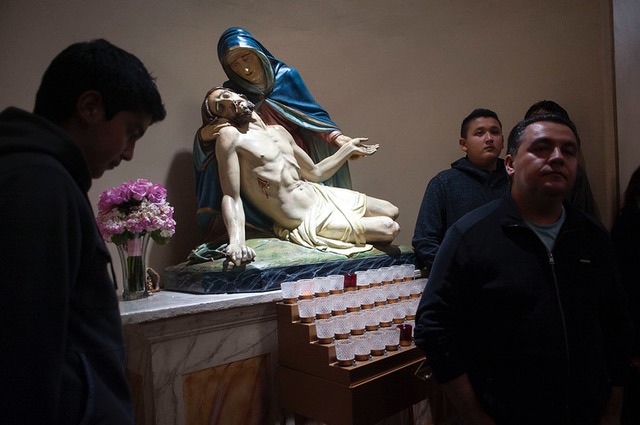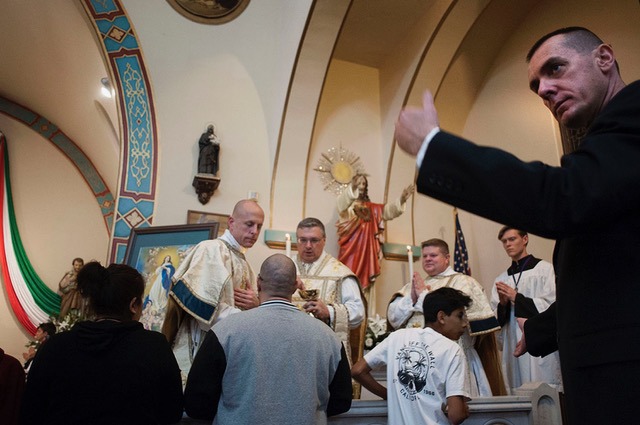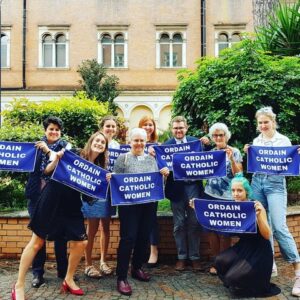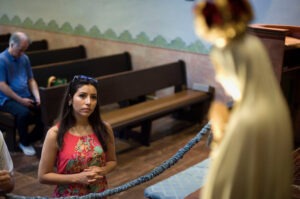The small congregation of Roman Catholic women gathered for Mass not in a church but a living room, with a woman presider rather than a male priest. After the homily, each of the women offered a brief reflection. They took Holy Communion in the form of bread, not a wafer. The group has met for twenty years, every other Sunday, alternating among living rooms in Oakland and Richmond, California, and during the pandemic they met on Zoom.
Catholics today do not celebrate Mass in a uniform way, an example of greater divisions over the role of women, acceptance of homosexuals, use of the old Latin Mass, even over allegiance to Pope Francis. This California house church is part of the fractured picture of Catholic worship. At the opposite pole are traditionalists who reject the modern Mass in English altogether, choosing instead what is called the Traditional Latin Mass (TLM), the rite used before the modernizing reforms of the landmark Second Vatican Council (Vatican II, 1962-65). For traditionalists the Latin Mass is more “authentic”; since 2007 when the conservative Pope Benedict approved its wider practice, the TLM has spread.
The great majority of the country’s church-going Catholics choose the ordinary English-language Mass, typically in a local parish. But no matter how they pray – house church, TLM, ordinary Mass — the different modes of worship, and the mode of preaching even in mainline parishes, reflect the points of contention that divides the U.S. Catholic Church.
“We call ourselves a fellowship of equals,” said Diana Wear, founder of the congregation that meets in members’ living rooms. “We follow the Catholic liturgy, although it’s much more friendly because we always use inclusive language.”
With a dozen others, Wear worships in an intimate setting that reflects a tradition rooted in the earliest days of Christianity when the faithful met in private houses. Some who attend are single, some married, some are nuns or former nuns. Elsewhere, Roman Catholic women priests, ordained by women bishops but unrecognized by the Vatican, may celebrate Mass in homes, or in spaces granted to them by non-Catholic congregations.
Wear, who is in her 70s, was once a university department administrator, and has advanced degrees in theology. She believes the church continues to invest too much authority and “magic” in the male priesthood. For years Wear preached at one of the local congregations of Dignity USA, a 50-year-old nationwide Catholic organization that advocates for a change in ecclesial teaching on homosexuality, which the Vatican considers an “objective disorder.” She is not “officially institutionally ordained,” Wear told me in a video interview, but “I can still teach and preach…do the work.”
House churches number in the thousands, of various denominations, but only a small, undetermined number call themselves Catholic, usually with men and women participants. But they are increasing at a time when a Gallup poll has shown that the number of Catholics belonging to a traditional parish dropped from 76 percent in 2000 to 58 percent in 2020.The unity of the Church, which proclaims itself as “one, holy, catholic and universal,” is being undermined by the threat of atomization.

“Schism isn’t coming, it’s here,” Kate McElwee, executive director of the Women’s Ordination Conference(WOC) told me in a video interview from her office in Rome. The WOC lobbies for a change in the Vatican’s stand against women priests. A 2019 NBC survey showed that a majority of Catholics, men and women and including religious sisters, believe Vatican-recognized female ordination should be open for discussion. Despite a fall in U.S. church membership – from about 82 million in 2015 to about 72 million today – Roman Catholics continue to represent the largest single religious denomination in the country. And its traditional and liberal sides remain effervescent. “The Church is most alive at its fringes” McElwee suggested.
Far from the picture of the house churches, with their informal settings and participatory liturgy, a formal Latin language Mass takes place monthly in a packed side chapel of the magnificent modern white Cathedral of St. Mary of the Assumption in San Francisco. Many women attending one recent day, when about 100 participants were present, wore mantillas or other head coverings, in the manner of female churchgoers before the reforms of Vatican II, which was called by Pope St. John XXIII to “let in the fresh air” and open the Catholic Church to the modern world. Most Catholics have not witnessed a rite like the Traditional Latin Mass (TLM) in their lifetimes, where the priest celebrates with his back to the faithful, and only males are allowed at the altar – no female servers or lectors. There was no organ or choir at this particular TLM, so the murmur of Latin words wafted over the congregation in a manner mysterious, or annoyingly unintelligible, depending on the worshipper’s frame of mind.
Increased interest in the Latin Mass is another indicator of the fissure in the Church. In 1964, when Vatican II decided that the Mass would henceforth be said in local languages, and Pope Paul VI wanted the liturgical reform to be expedited, the reaction of congregants, as one reported survey indicated, was “overwhelmingly positive.” Fifty years later, the TLM has become a cudgel in the hands of those who would weaken Pope Francis, a champion of the Vatican II reforms.
The Latin Mass never disappeared. Elderly priests accustomed to the old rite were permitted to continue with it. A France-based breakaway, the Society of St. Pius X (SSPX), founded in 1971, continues to hold the Latin Mass as a central rite; today the society has about 600,000 adherents in a global Catholic population of 1.3 billion, including 30,000 in the United States. Followers consider themselves practicing Catholics, although the SSPX rejects Vatican II reforms and administers its own schools, chapels, and presses. The Vatican considers the group schismatic, the marriages and other sacraments over which its clergy preside invalid, but given the surge in ultraconservatism in the Church in recent years, SSPX might be considered a centrist group among traditionalists. Today “[T]hey’re the moderates of the movement,” Michael Cuneo, a professor of sociology at Fordham University in New York City, has suggested.
In 2007, Pope Benedict XVI allowed widespread use of the Latin Mass, saying he aspired to “unity” among the faithful. Some Catholics began to seek it out, considering it more authentic and rooted in tradition than the Mass in ordinary languages. In fact, it was the “new” non-Latin Mass that revived elements of worship from the earliest centuries of Christianity, while the “traditional” Latin Mass dates only from 1571. During the COVID lockdowns, some believers attended live streamed Latin Masses for the first time while other parishes were closed.

“Schism isn’t coming, it’s here,” Kate McElwee, executive director of the Women’s Ordination Conference(WOC) told me in a video interview from her office in Rome. The WOC lobbies for a change in the Vatican’s stand against women priests. A 2019 NBC survey showed that a majority of Catholics, men and women and including religious sisters, believe Vatican-recognized female ordination should be open for discussion. Despite a fall in U.S. church membership – from about 82 million in 2015 to about 72 million today – Roman Catholics continue to represent the largest single religious denomination in the country. And its traditional and liberal sides remain effervescent. “The Church is most alive at its fringes” McElwee suggested.
Far from the picture of the house churches, with their informal settings and participatory liturgy, a formal Latin language Mass takes place monthly in a packed side chapel of the magnificent modern white Cathedral of St. Mary of the Assumption in San Francisco. Many women attending one recent day, when about 100 participants were present, wore mantillas or other head coverings, in the manner of female churchgoers before the reforms of Vatican II, which was called by Pope St. John XXIII to “let in the fresh air” and open the Catholic Church to the modern world. Most Catholics have not witnessed a rite like the Traditional Latin Mass (TLM) in their lifetimes, where the priest celebrates with his back to the faithful, and only males are allowed at the altar – no female servers or lectors. There was no organ or choir at this particular TLM, so the murmur of Latin words wafted over the congregation in a manner mysterious, or annoyingly unintelligible, depending on the worshipper’s frame of mind.
Increased interest in the Latin Mass is another indicator of the fissure in the Church. In 1964, when Vatican II decided that the Mass would henceforth be said in local languages, and Pope Paul VI wanted the liturgical reform to be expedited, the reaction of congregants, as one reported survey indicated, was “overwhelmingly positive.” Fifty years later, the TLM has become a cudgel in the hands of those who would weaken Pope Francis, a champion of the Vatican II reforms.
The Latin Mass never disappeared. Elderly priests accustomed to the old rite were permitted to continue with it. A France-based breakaway, the Society of St. Pius X (SSPX), founded in 1971, continues to hold the Latin Mass as a central rite; today the society has about 600,000 adherents in a global Catholic population of 1.3 billion, including 30,000 in the United States. Followers consider themselves practicing Catholics, although the SSPX rejects Vatican II reforms and administers its own schools, chapels, and presses. The Vatican considers the group schismatic, the marriages and other sacraments over which its clergy preside invalid, but given the surge in ultraconservatism in the Church in recent years, SSPX might be considered a centrist group among traditionalists. Today “[T]hey’re the moderates of the movement,” Michael Cuneo, a professor of sociology at Fordham University in New York City, has suggested.
In 2007, Pope Benedict XVI allowed widespread use of the Latin Mass, saying he aspired to “unity” among the faithful. Some Catholics began to seek it out, considering it more authentic and rooted in tradition than the Mass in ordinary languages. In fact, it was the “new” non-Latin Mass that revived elements of worship from the earliest centuries of Christianity, while the “traditional” Latin Mass dates only from 1571. During the COVID lockdowns, some believers attended live streamed Latin Masses for the first time while other parishes were closed.

“I personally deserve attacks and insults because I am a sinner, but the church does not deserve them,” he said.
For Francis, the spirit and letter of the Second Vatican Council are the sine qua non of today’s church. Either you accept the Council’s reforms, aimed at bringing the institution out of a fortress mentality and into engagement with the modern world, or you are not a faithful Catholic. As a result, a phenomenon called sedevacantism, from the Latin for “empty seat,” has emerged among the most radical traditionalists (“radtrads”). They assert that Francis is an illegitimate pope because of his embrace of the modern reforms. They may also deny Vatican II principles such as the pre-eminence of one’s conscience, religious freedom, ecumenism and inter-faith dialogue, respect for Moslems and Jews. The Latin Mass is a hallmark of practice among many restorationists, who would go back to the Church of the 1950s.
The TLM is divisive “because many adherents (and opponents) consider the [it] part and parcel with a rejection of the theology of Vatican II as a whole,” said a Jesuit publication, America. John Baldovin, a Jesuit professor of historical and liturgical theology at the Boston College School of Theology and Ministry, told the magazine, “many younger priests and seminarians are devotees of the former [Latin] rite—and worse, try to impose it upon their congregations.”
In today’s troubled church, the Latin Mass looms larger than the relatively small number of its adherents might indicate, partly because among supporters are the most wealthy and powerful of the faithful, such as those who gather yearly at millionaire Tim Busch’s Napa Institute conferences for connection-making, wine tasting and traditional devotional practice. The TLM has come to symbolize resistance to the leadership of the current Supreme Pontiff, his stand against unrestricted capitalism, and for attention to the climate crisis and care for the poor. Many elements are “contributing to a possible schism today,” said Baldovin. “But it would not be surprising if a church that went into schism gravitated to the pre-Vatican II liturgy.”
Although most Catholics attend parishes with post-Vatican II rites, they are not untouched by ferment at the community’s fringes. A liturgist in the San Francisco Bay Area who serves a parish with “a really interesting cross section of people,” said some were drawn to this particular church by its elegant pre-Vatican II look; others by the involvement of some parishioners in climate change activism. “In the face of the faithful I am always middle of the road,” said the liturgist. “I don’t want the pastor getting nasty-grams at the end of Mass on Sunday.”
But finding the middle path can be difficult. The “nasty-grams” come anyway.
A prayer offered for people experiencing racial injustice was interpreted by a police officer as “an affront to the work I have been doing,” he wrote in an angry email to the pastor. After witnessing a valiant municipal driver brave rain, darkness and impatient passengers to help a disabled man onto a bus, the liturgist added a prayer on another Sunday that public transit employees receive support and a just wage. But more umbrage came: “I got two emails from people who were very upset that the parish was sponsoring a public transit union. [It wasn’t.] And one of them asked, ‘how dare we’ imply that public transit workers should be paid more, because they’re already being paid too much?”

Maggie Warner, 36, is a convert to Catholicism who once belonged to a Protestant church that went through a split which has remained “really fresh in my heart,” an experience of division that had “a deep impact on my family.” Now a cantor in a large Catholic parish in San Francisco, and a theology student, she is acutely aware of forces pulling at the faithful, but takes hope because she sees history as a “pendulum moving back and forth between unity and diversity.”
That is not to say that Warner, as a woman in a male-dominated institution, does not recognize where things might be better. “I’ve been very fortunate in the work that I’ve done that I have had a great deal of responsibility and a great deal of authority,” she told me. But the road has not been easy and it has taken a great deal of time. “It takes a priest two days to earn the kind of trust and pastoral currency that it takes me five years to earn,” she sais.
Yet Warner is in the sanctuary every Sunday, offering chosen songs in a beautiful voice in prayer with congregants, united in worship during Mass.
“It’s such a struggle,” she said, “to figure out how to be together on big unwieldy steps and understand God.”
How then are Catholics going to confront the divisions in today’s church at a global level, sometimes manifested in vastly different forms of worship in the United States – house churches, the Traditional Latin Mass, the ordinary parish Sunday service?
In May 2021 Pope Francis announced an initiative in “synodality,” called the most important Catholic global project since Vatican II. In the process, Catholic rank and file, clergy and hierarchy are being called to discuss the direction of the Church at every level, culminating in a Synod of Bishops in Rome in October, 2023. The idea is to take into account the full spectrum of ideas of “the people of God,” as Vatican II has called all who make up the institution.
“Up till now particular agendas and idiosyncratic movements have monopolized the conversation, ” wrote the Italian theologian Massimo Faggioli in La Croix International. For some, the role of women will be most pressing, for others the preservation of beloved traditions. Francis has warned that the years of the synod would not be like a “parliament,” however, with individuals pushing causes and favorite reforms, but a profound process of listening to each other, through which the people of the Church might discern the will of God. “Listen to Him by listening to yourselves and do not leave anyone out or behind,” the pope said in a discourse about the Synod. 4
Faggioli, who specializes in the U.S. Church and teaches at Villanova University, wrote that, “This new process is, in a sense, an act of rebalancing the politics that will have to have preferential options in the Church.”

By the time the Synod process culminates Pope Francis will be 87. At that age most popes have died. The Synod is planned to continue with or without the presence of Pope Francis, just as Vatican II continued after the death of the pontiff who called it, John XXIII. Many of the faithful say they live in hope that the “listening” process will result in a renewed Church as the bishops meet in 2023. Nevertheless, it is not clear whether the myriad fissures in the Church will be on the mend by then or widened to the point of destabilizing the institution beyond repair.
Mary Jo McConahay examined the role of women in the Catholic church during her fellowship year. Her work contributed to her latest book, “Playing God, American Catholic Bishops and the Far Right.” (Penguin/Random House).




